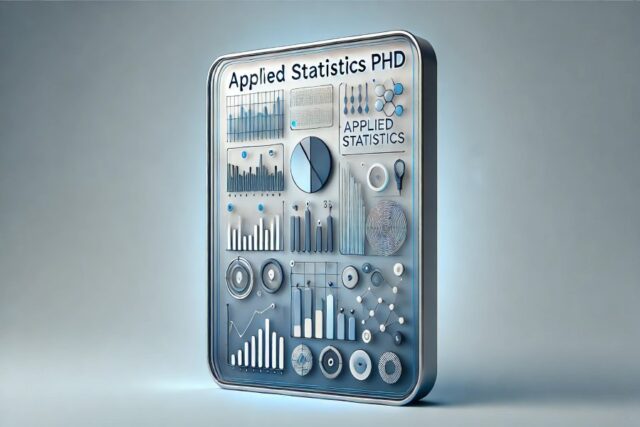An Applied Statistics PhD program provides individuals with doctoral training in statistical theory and methodology to solve real-world problems in various sectors, such as academia, government, industry, and research organizations. Obtaining a PhD in Applied Statistics opens up a multitude of career opportunities due to the increasing demand for professionals with expertise in statistics.
This program goes beyond pure statistics by focusing on the practical application of statistical methods. With a research-intensive curriculum, students gain an in-depth understanding of statistical tools and techniques. The University of Texas at San Antonio and the University of Alabama are among the institutions offering Applied Statistics PhD programs.
Completing this program demonstrates the ability to independently conduct research and apply statistical methods effectively.
The Essence Of An Applied Statistics PhD
The essence of an Applied Statistics PhD lies in its practical application of statistical methods to solve real-world problems across various sectors, such as academia, government, industry, and research organizations. With a growing demand for individuals with expertise in statistics, this doctoral program offers diverse career opportunities and an in-depth understanding of statistical tools for research.
Career Prospects For Graduates
As the use of data continues to increase across all industries, the demand for individuals with expertise in statistics is also on the rise. Graduates with a PhD in Applied Statistics are well-positioned to pursue a variety of career paths, including roles in academia, government, research organizations, and the private sector.
Industry Demand For Statistical Expertise
Industries such as finance, healthcare, and technology are increasingly relying on statistical analysis to inform decision-making and drive business outcomes. As a result, there is a growing need for individuals with advanced statistical skills who can apply their knowledge to real-world problems. Graduates with a PhD in Applied Statistics are highly sought after by employers in these industries and can expect to have a wide range of career opportunities available to them.
An Applied Statistics PhD is a research-focused program designed to provide students with a deep understanding of statistical theory and methodology, as well as the ability to apply these skills to real-world problems. Unlike traditional statistics programs that focus primarily on the numbers and math, an Applied Statistics PhD emphasizes the practical application of statistical methods to solve complex problems and drive business outcomes.
Graduates of an Applied Statistics PhD program have a unique skill set that is highly valued in today’s data-driven economy. They are able to use statistical analysis to identify patterns and trends in data, create predictive models, and communicate their findings to stakeholders in a clear and concise manner. This combination of technical expertise and business acumen makes them invaluable assets to any organization looking to leverage data to drive growth and innovation.
Comparing Pure And Applied Statistics
When it comes to pursuing a Ph.D. in Applied Statistics, one of the key considerations is understanding the differences between pure and applied statistics. By comparing these two fields, prospective students can gain insight into the unique characteristics and applications of each area of study. This comparison can help individuals make informed decisions about their academic and career paths.
Core Differences In Curriculum
Pure statistics focuses primarily on the numbers, math, and problems themselves. On the other hand, applied statistics can be thought of as “statistics-in-action” or using statistics with an eye toward real-world problems and their solutions. Applied statistics involves a more practical approach, emphasizing the application of statistical methods to solve real-world challenges. This distinction is reflected in the curriculum, with pure statistics programs placing greater emphasis on theoretical concepts and mathematical foundations, while applied statistics programs incorporate practical applications and case studies.
Real-world Application And Impact
One of the defining features of applied statistics is its real-world relevance and impact. Students pursuing a Ph.D. in Applied Statistics are exposed to a wide range of practical applications across various industries, including business, healthcare, environmental science, and technology. This exposure allows them to develop a deep understanding of how statistical methods can be utilized to address complex, real-world problems and make data-driven decisions. In contrast, pure statistics programs may focus more on theoretical research and mathematical modeling, with less emphasis on practical implementation and real-world impact.
The Financial Return On A Statistics PhD
Earning a Statistics PhD can yield a strong financial return due to high demand in various sectors. Applied Statistics PhD holders can secure lucrative career opportunities in academia, government, industry, and research, leveraging statistical expertise to solve real-world problems effectively.
Salary Expectations
When considering pursuing a Ph.D. in Applied Statistics, one of the key factors to consider is the potential financial return on your investment. Statistics is a field that is in high demand across various industries, and this demand is only expected to grow in the future. As a result, individuals with advanced degrees in Applied Statistics can expect to earn competitive salaries.
Investment Vs. Reward Analysis
Before deciding to pursue a Ph.D. in Applied Statistics, it is essential to evaluate the investment versus the potential rewards. While obtaining a Ph.D. requires significant time, effort, and financial resources, the potential rewards can outweigh the costs.
Here is a breakdown of the investment versus reward analysis:
- Investment: Pursuing a Ph.D. in Applied Statistics typically takes 4-6 years of full-time study. During this time, you must invest in tuition fees, books, research materials, and living expenses.
- Reward: Upon completing your Ph.D., you will have a highly specialized skill set in high demand. This can lead to various career opportunities with competitive salaries in academia, government, industry, and research organizations.
According to a study conducted by Interview Query, the average salary for individuals with a Ph.D. in Statistics ranges from $90,000 to $130,000 per year. However, it is important to note that salary expectations can vary based on factors such as industry, location, level of experience, and job responsibilities.
| Industry | Salary Range |
|---|---|
| Academia | $90,000 – $120,000 |
| Government | $95,000 – $130,000 |
| Industry | $100,000 – $140,000 |
| Research Organizations | $95,000 – $125,000 |
It is important to consider the potential long-term financial stability and growth opportunities that a Ph.D. in Applied Statistics can provide. With the increasing demand for statistical expertise, individuals with advanced degrees in this field are well-positioned for rewarding and lucrative careers.
Navigating The Challenges Of A Statistics PhD
Navigating the challenges of an Applied Statistics PhD involves mastering complex statistical methods and applying them to real-world scenarios. The program equips students with expertise to tackle business problems across various sectors like academia, government, and research organizations. Pursuing a PhD in Applied Statistics opens up lucrative career opportunities in a data-driven world.
Academic Rigor And Research Intensity
Embarking on a Statistics PhD entails significant academic rigor and research intensity. The journey involves delving deep into statistical theories, methodologies, and complex data analysis.
Balancing Theory And Practice
In a Statistics PhD Balancing theory and practice is paramount in a statistics Ph.D. Applying theoretical concepts to real-world scenarios is essential, ensuring a holistic understanding of statistical principles.
Top Institutions For Applied Statistics Ph.D.
When pursuing a PhD in Applied Statistics, choosing the right institution is crucial for a successful academic and research career. Below are some of the top institutions known for their exceptional Applied Statistics PhD programs.
Program Highlights
Here are some of the top institutions offering exceptional Applied Statistics PhD programs:
| Institution | Location |
|---|---|
| University of Texas at San Antonio | San Antonio, Texas |
| University of Alabama | Alabama |
Research Opportunities And Facilities
These institutions provide extensive research opportunities and state-of-the-art facilities for students pursuing a PhD in Applied Statistics. Their research-intensive programs ensure that students gain an in-depth understanding of statistical tools and methodologies.
Frequently Asked Questions
Is A Phd In Applied Statistics Worth It?
A PhD in applied statistics is worth it due to the increased career opportunities available in various sectors.
How Useful Is A Phd In Statistics?
A PhD in statistics is highly useful and offers diverse career opportunities in academia, government, industry, and research.
What Is The Difference Between Applied Statistics And Statistics Degree?
Applied Statistics focuses on using statistical methods to solve real-world problems, while a statistics degree emphasizes numbers and math. Applied Statistics is practical and applicable.
Which Phd Pays Most?
A PhD in Applied Statistics is known for offering high-paying career opportunities across various sectors. It’s a valuable investment in statistical expertise that leads to lucrative prospects in academia, government, industry, and research organizations. Applied Statistics PhD programs are designed to equip students with the necessary skills for success.
Faq 1: What Are The Benefits Of Pursuing A Ph.D. in Applied Statistics?
A PhD in Applied Statistics offers numerous benefits, including enhanced career opportunities in academia, government, industry, and research organizations. It provides in-depth knowledge and expertise in statistical theory and methodology, enabling individuals to solve complex real-world problems using statistical methods.
Faq 2: How Does Applied Statistics Differ From A Traditional Statistics Degree?
While a traditional statistics degree focuses primarily on numbers, math, and theoretical problems, Applied Statistics goes beyond that. It involves the practical application of statistics to real-world problems, seeking solutions and insights that can be implemented in various fields. Applied Statistics allows for a pragmatic and action-oriented approach to statistical analysis.
Conclusion
Overall, pursuing a PhD in Applied Statistics can be a wise career choice due to the high demand for professionals with expertise in this field. With a PhD in Applied Statistics, graduates can explore various career opportunities across academia, government, industry, and research organizations.
Additionally, Applied Statistics programs offer a practical approach to solving real-world problems, making it a valuable skill set in today’s data-driven world. With research-intensive programs and independent study opportunities, students can gain an in-depth understanding of statistical tools and methodology.
Therefore, if you’re passionate about statistics and enjoy solving complex problems, a PhD in Applied Statistics can be a challenging yet rewarding experience.














